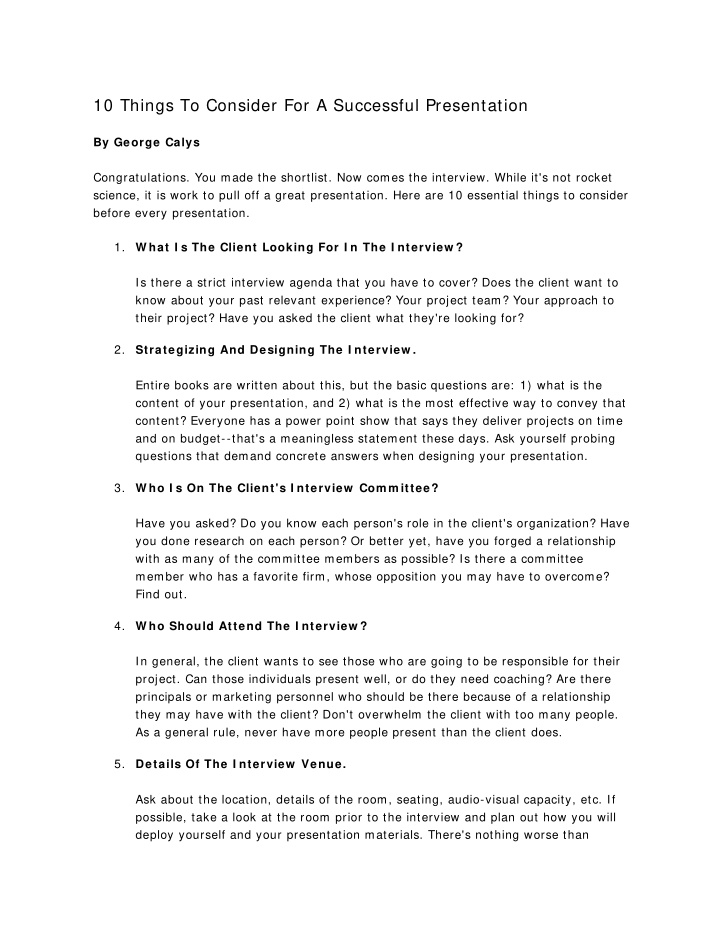



10 Things To Consider For A Successful Presentation By George Calys Congratulations. You made the shortlist. Now comes the interview. While it's not rocket science, it is work to pull off a great presentation. Here are 10 essential things to consider before every presentation. 1. W hat I s The Client Looking For I n The I nterview ? Is there a strict interview agenda that you have to cover? Does the client want to know about your past relevant experience? Your project team? Your approach to their project? Have you asked the client what they're looking for? 2. Strategizing And Designing The I nterview . Entire books are written about this, but the basic questions are: 1) what is the content of your presentation, and 2) what is the most effective way to convey that content? Everyone has a power point show that says they deliver projects on time and on budget--that's a meaningless statement these days. Ask yourself probing questions that demand concrete answers when designing your presentation. 3. W ho I s On The Client's I nterview Com m ittee? Have you asked? Do you know each person's role in the client's organization? Have you done research on each person? Or better yet, have you forged a relationship with as many of the committee members as possible? Is there a committee member who has a favorite firm, whose opposition you may have to overcome? Find out. 4. W ho Should Attend The I nterview ? In general, the client wants to see those who are going to be responsible for their project. Can those individuals present well, or do they need coaching? Are there principals or marketing personnel who should be there because of a relationship they may have with the client? Don't overwhelm the client with too many people. As a general rule, never have more people present than the client does. 5. Details Of The I nterview Venue. Ask about the location, details of the room, seating, audio-visual capacity, etc. If possible, take a look at the room prior to the interview and plan out how you will deploy yourself and your presentation materials. There's nothing worse than
arriving at the interview only to find that there's no place to plug in your projector or nowhere to place your beautifully rendered boards. 6. Preparing For The I nterview . Remember Joe Montana's beautifully executed passes? Or Michael Jordan's clutch shots? How many times do you think they went through those situations in practice? Failure to adequately rehearse your interview is one of the most consistently made mistakes. Rehearsing your interview is not sitting around talking about the interview. Rehearsal means doing the interview just as if you were in front of the client. Say the exact words you are going to say. Time your presentation so you know it fits in the allotted time. Practice your Q&A responses so that you're not surprised or tongue-tied in the real interview. Consider using an interview coach for very competitive interviews. An interview is a performance; professionals rehearse before every performance. Does it all take a lot of time? Of course it does, but so does losing the project because you fumbled in the interview. 7. At The I nterview . In a word, be relaxed. If you're the type who is jittery before speaking, find ways to loosen up just before the interview. What do you wear to the interview? Reflect the client's expectations in attire. A Fortune 500 client in New York expects a different style than a dot com client in Silicon Valley. The same thing goes with introductions. Sometimes hand shaking and small talk is expected, and sometimes sitting down immediately and getting down to business is the right way. Your body language is critical. Look your clients in the eye when speaking. When others are speaking, pay attention to them and don't shuffle through your notes. If you have nervous mannerisms, now is the time to lose them. If you need written talking points, fine, use them, but don't be fixated on reading from a piece of paper. 8. Respect Your Client's Tim e. Be early to the interview. If you're out of town, make sure you know exactly how to get to the interview. If the client has given you 30 minutes to present and 15 minutes for Q&A, stick to it unless the client clearly lets you know you can take extra time. In any case, remember the adage that the more you say, the less they hear.
9. Leave Behinds. These are the written or graphic materials you leave with the client at the end of the interview. Don't pass them out at the beginning because this allows the committee to look at the leave behinds instead of listening to your presentation. Have your business cards included with the leave behinds so that you don't have to do the awkward business card exchange. 10. After The I nterview . Call your contacts both on and off the interview committee. Thank them and let them know you're interested in the project. If you sense or find out that you made a major blunder in the interview, determine whether any damage control is possible. For better or worse, interviews are a staple of getting business in the professional world. When preparing them, treat them like the performance that they are. When giving them, be at ease and natural. Consider these 10 basics and you'll be on your way to a winning presentation. George Calys is an architect and writer with over 20 years in marketing professional services. His firm, Acumen, provides architects, engineers, and contractors with the business development, communications, and marketing tools they need to grow and succeed. George may be reached at gcalys@acumen-marketing.com.
Recommend
More recommend